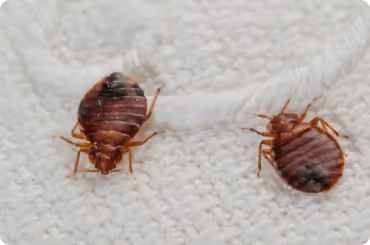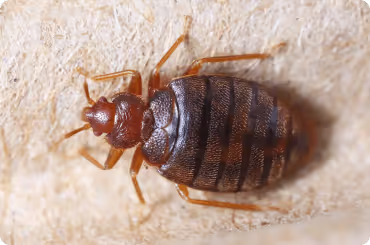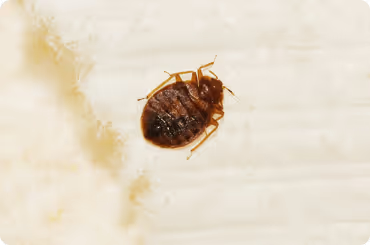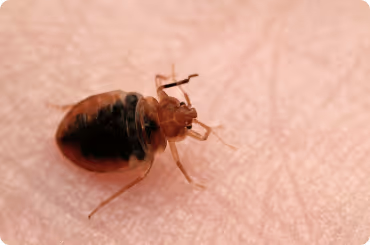What are Bed Bugs?
Bed bugs are small, parasitic insects that feed on the blood of humans and animals, typically during the night. They are oval-shaped, flat, and wingless, making them excellent at hiding in tight spaces. Adults are brown but turn reddish after feeding. Though small, bed bugs are visible to the naked eye, growing up to 4–5 mm in length. They are not a sign of uncleanliness and can infest even the cleanest homes. Bed bugs are skilled hitchhikers, often entering homes through luggage, used furniture, or clothing.

What Kinds of Bed Bugs Are There?

Worldwide, the common or household bedbug ( Cimex lectularius ) can be found. These insects are able to adapt to humans and live in warm climates. Many other pests are similar to bed bugs in appearance and habits. It is usually necessary to use magnification and have experience in identifying the species.

Worldwide, the common or household bedbug ( Cimex lectularius ) can be found. These insects are able to adapt to humans and live in warm climates. Many other pests are similar to bed bugs in appearance and habits. It is usually necessary to use magnification and have experience in identifying the species.

Bat bugs (Cimex adjutus), have been seen in both tropical and temperate regions. Although they primarily feed on bats, this species can also feed on humans, particularly if their preferred food source is not available.

The Mexican chickenbug (Haematosiphon imodora), which is primarily found in North America, closely resembles the common bedroom bug. These insects prefer domestic fowl and bird species to be their hosts.
Identifying Bed Bugs and Their Hiding Spots
Bed bugs are most active at night and prefer to hide in areas close to their hosts during the day. Common bed bug hiding places include mattress seams, box springs, headboards, cracks in furniture, and baseboards. They may also be found behind picture frames or inside electrical outlets. Their ability to squeeze into tiny spaces makes them difficult to detect without close inspection.
The Life Cycle of Bed Bugs
A bed bug’s life begins as an egg, which is grain-like and white. Females lay 1–5 eggs daily, depositing them in cracks, crevices, or seams. The eggs hatch in about 6–10 days, releasing nymphs that immediately seek a blood meal to grow.
Nymphs go through five stages of molting before reaching adulthood, a process that takes approximately 4–6 weeks under ideal conditions. Adult bed bugs feed weekly and can live for several months, even up to a year, if food is scarce.
Recognizing an Infestation
Early detection is key to preventing a widespread infestation. Signs of bed bugs include:
- Red, itchy bites on exposed skin, often in clusters or lines.
- Small, dark stains (fecal spots) on bedding or furniture.
- Shed skins left behind as nymphs grow.
- Live bugs hiding in cracks, crevices, or fabric seams.
Inspect areas around the bed and other furniture closely if you suspect their presence.
Myths About Bed Bugs
There are several misconceptions about bed bugs. Contrary to popular belief, bed bugs are not too small to see; adults are visible to the naked eye. Another myth is that they only infest dirty homes. In reality, bed bugs are attracted to warmth and blood, not dirt, and can be found in even the most well-kept homes. While their bites can cause irritation and allergic reactions, there is no conclusive evidence that bed bugs spread diseases.
Getting Rid of Bed Bugs
Eliminating bed bugs is a challenging task that often requires professional intervention. Start by washing and drying all infested bedding and clothing on the highest heat setting. Vacuum furniture, carpets, and crevices thoroughly, and seal the vacuum bag before disposing of it in an outdoor trash bin.
Using protective covers on mattresses and box springs can trap bed bugs and prevent new infestations. However, these steps alone may not be enough for severe cases. Professional pest control ensures complete eradication with targeted treatments tailored to your specific needs.
Preventing Bed Bugs
Preventing bed bug infestations involves a combination of vigilance and proactive measures. Inspect second-hand furniture and clothing before bringing them into your home. After traveling, wash and dry clothes and bedding immediately, and check your luggage for signs of pests. Decluttering your home can also help reduce potential hiding spots.
How Alta Pest Control Can Help
At Alta Pest Control, we offer specialized bed bug treatments designed to eliminate infestations and prevent their return. Our process begins with a thorough inspection to identify the severity of the problem. We then implement a customized treatment plan using environmentally friendly products that are child- and pet-friendly.
We proudly serve the following locations for bed bugs:
Bed bug infestations can be stressful, but with our proven methods and expertise, you can regain your peace of mind. Contact us today for professional bed bug control and a bed bug-free home.
